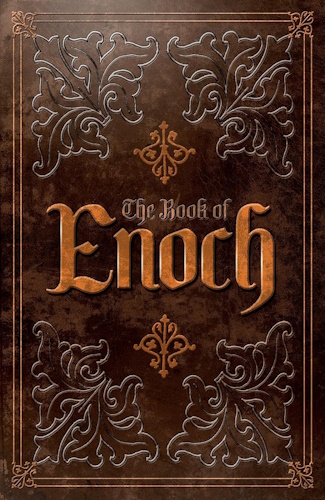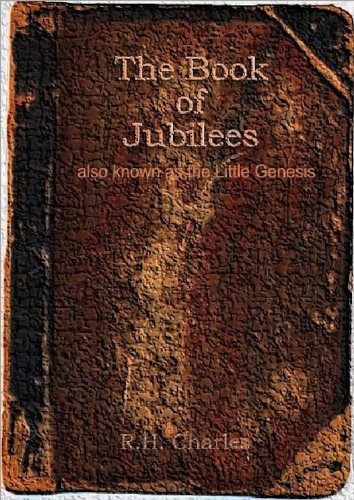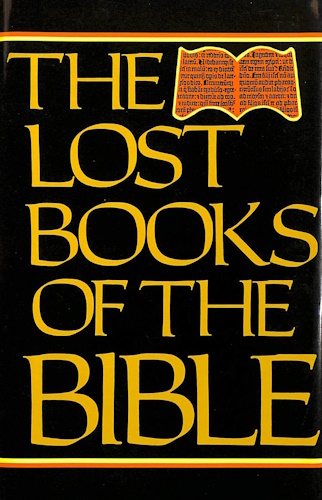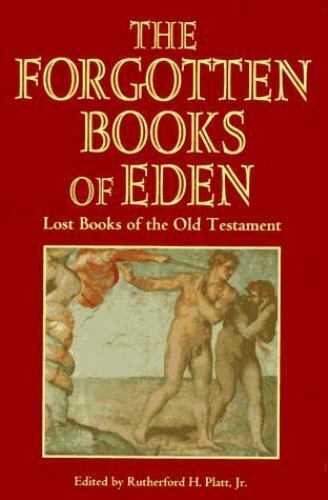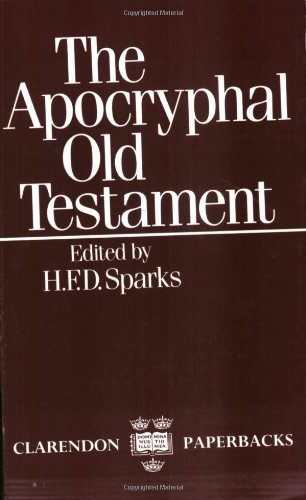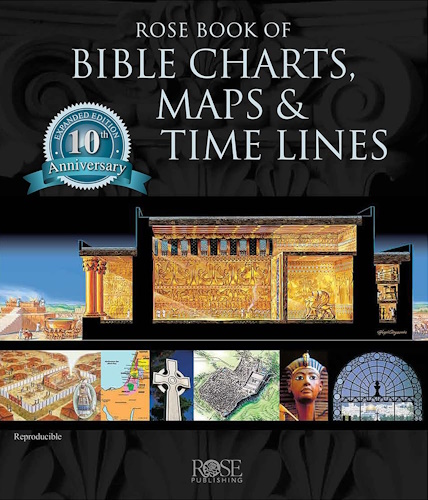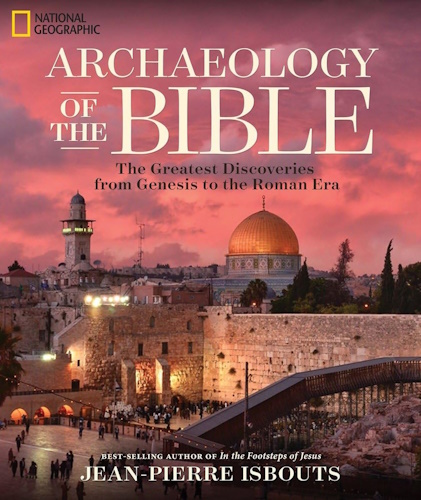
LADDER OF JACOB
By way of appendix to the fragments of lost books I should like to add one or two notices of apocrypha which do not quite fit into the framework of the main part of the book.
The first of these is the Ladder of Jacob, which exists in two recensions in Slavonic, and was translated by Bonwetsch in the Gottingen Nachrichten, 1900 (p. 76). I depend upon his text for my rendering.
The first recension, contained in a single MS, rather mutilated, of 1494, in the Rumjancov Museum at Moscow, gives the most original text. The other has been printed by various Russian scholars and, like other apocrypha, is found in the text of the Palaea or Old Testament History.
(Rec. 2): Now Jacob went to his Uncle Laban, and he found a place and fell asleep there, laying his head on a stone, for the sun was set: and there he saw a vision.
(Rec. 1 begins): And lo! a ladder was set up on the earth, whose top reached unto heaven. And the top of the ladder was a face as of a man, hewn out of fire. Now it had twelve steps up to the top of the ladder, and upon each step up to the top were two human faces on the right and on the left -- twenty-four faces seen to their breast, on the ladder. But the middle face was higher than them all, which I saw made of fire, to the shoulder and the arm, very terribly, more than the twenty-four faces. And as I looked, behold, the Angels of God ascending and descending thereon but the Lord was set above it, and he called me, saying: Jacob, Jacob. And I said: Here am I, Lord; And he [97] said to me: The land whereon thou sleepest I will give to thee and to thy seed after thee: and I will multiply thy seed as the stars of heaven and as the sand of the sea; through thy seed shall all the earth be blessed, and they that dwell thereon, unto the last times, the years of the end. My blessing wherewith I have blessed thee shall pour out from thee unto the last generation. All in the east and the west shall be full of thy seed.
2. And when I heard it from above, fear and trembling fell upon me, and I rose up from my dream. And while the Voice of God was yet in mine ears, I said: How dreadful is this place ! this is none other but the house of God, and this is the gate of heaven. And I set up the stone that was under my head for a pillar, and poured oil on the top of it, and I called the name of that place the house of God (a line gone: Rec. 2 suggests the supplement: And I prayed to God and said): Lord God of Adam, of thy (creature?), and Lord God of Abraham and Isaac my father, and of all whose ways are right before thee, thou that sittest mighty upon the Cherubim and upon the throne of the majesty, of fire and full of eyes, as I saw in my dream; that holds the Cherubim with four faces, that bears the Seraphim full of eyes, that bears the whole world under his arm, and is borne of none. Thou hast established the heaven for the glory of thy name. Thou hast spread out upon the clouds of the heaven the heaven that flieth (resteth ?) under thee, that under it thou mayest move the sun and hide it in the night lest it be held for God: thou bast ordained the way for the moon and the stars, and her thou makest to wax and wane, but for the stars, thou bast commanded them to pass over, lest these also should be supposed gods. Before the face of thy majesty the six-winged Seraphim fear, and hide their feet and their face with their wings, and with the others they fly, and sing (two lines gone: no help from Rec. 2, which omits all this invocation) Highest, with twelve faces, many-named, fiery, lightning-formed, holy one! Holy, Holy, Holy, Jao Jaova, Jaoel, Sabakdos, Chabod, Sabaoth, Omlelech, Elaber, Ame(?) S'me Barech, [98] eternal king, strong, mighty, very great, long-suffering, Blessed One, that fillest heaven and earth and the sea and the abyss and all aeons with thy glory. Hear my song wherewith I have praised thee, and grant me my petition for which I pray to thee, and show me the interpretation of my dream. For thou art strong and mighty and glorious, a holy God, the Lord of me and of my fathers. (This rather resembles the Prayer in the Apocalypse of Abraham, of which a translation is published in this series.)
3. And while I yet spake my prayer, there appeared a voice (!) before my face saying: Sarekl, prince of them that rejoice (or of the servants), thou that art over visions, go make Jacob to understand the interpretation of the dream which he saw, and show him all things whatsoever he saw: but first bless him. And the archangel Sarekl came to me, and I saw: it was a face (a line gone) terrible. But I did not fear before his look, for the face which I had seen in my dream . . . was more than this, and I feared not the face of an angel. And the angel said to me: What is thy name? and I said: Jacob. But I (read he said to me) Thy name shall not henceforth be called Jacob, but thy name shall be like my name, Israel. And when I came from Fandana (cf. Apocalypse of Abraham, 2) in Syria to meet my brother Esau, he came to me and blessed me, and called my name Israel, and told me not his name until I adjured him, and then he told me: Because thou wast . . . [There is confusion here, it seems, between the two incidents of the ladder and the wrestling. I have wondered whether a dim reflection of the `Prayer of Joseph' is to be traced in this paragraph, but the text is evidently in a bad state. Rec. 2 has merely the statement that an angel came and said he was sent to interpret the vision.]
4. But this said he to me: The ladder which thou sawest, which had twelve steps having two human faces which changed their appearance --now this ladder is this age, and the twelve steps are the times of this age, and the twenty-four faces are the kings of [99] the lawless heathen of this age. Under these kings will be tried (line gone: Rec. 2 thy children's children and the line) of thy sons: they will rise up against the lawlessness of thy descendants and will lay this place waste through four descents (because ?) of the sins of thy descendants, and of the substance of the forefathers will be built this palace in the temple of the name of thy God and thy fathers (? the palace of the temple in the name of the God of thy fathers); but through the wrath of thy descendants will it be desolate until (Rec. 2 in) the fourth descent of this age: for thou didst see four visions (or faces).
5. The first that stumbleth upon the steps . . . angels ascending and descending and faces in the midst of the steps: the Most High will raise up an heir of the descendants of thy brother Esau, and all the lords of the nations of the earth will accept it, who have done evil against thy seed, and will be given into his hand, and he will be hardly borne by them. But he beginneth to rule them with violence and to reign over them, and they cannot resist him, until the day when his decree goeth forth against them to serve the idols (line gone) and to all them that appear in such a cause, and so many . . . of thy race, so many to Thalkonagargael.
[Rec. 2:The first that stumbleth upon the steps will be a king of thy neighbours and will do evil against thy seed; he will be unwillingly borne by them. But then beginneth he to rule over them, and with violence to reign over them, and they cannot resist him, and his decree groweth against them that they should worship idols and sacrifice to the dead (the deified Emperor) and he speaketh to use force to all that are in his kingdom, which appear in such an accusation, so many to the Most High out of thy race, and so many to Thalkonagargael.]
6 (Rec. 1): And know thou, Jacob, that thy seed shall be strangers in a strange land, and men will illtreat them with bondage and lay blows on them daily but the people whom they serve will the Lord judge. When a king ariseth and fighteth, then will there be to [100] that place (al. when the Most High giveth his judgment to that place, he will lead forth) then will thy seed, even Israel, go forth out of the bondage of the heathen who ruled over them with violence, and will be set free from all reproach of their enemies. For, this king is the head of every revenge: and retribution of them that make attacks on thee, Israel. And the (at the?) end of the age (sic). For the miserable will rise and cry, and the Lord heareth then, and will be softened, and the mighty letteth himself pity their sufferings, because the angels and archangels pour out their prayers for the saving of thy race. Then will their women bear much fruit, and then will the Lord fight for thy race. Here the oldest M S. ends.
Rec. 2: And know thou, Jacob, etc. to will the Lord judge, For the Most High will let himself pity, etc. to the saving of thy race, that the Most High may have compassion; then will their women bear much fruit, and then fighteth the Lord for thy race with terrible and great signs, for the bondage inflicted on then. Their full storehouses will be found empty of wine and of every fruit: their land will boil over with creeping things and every deadly thing. Earthquakes and much destruction will there be. Then will the Most High accomplish his judgment on that place, and will lead forth thy seed out of the bondage of the heathen which rule over them with violence, and they will be saved from the reproaches of their enemies. But the head of the king will be for (an object of) revenge:bitterly standeth he up against them, but they cry, and the Lord heareth them and poureth out his wrath upon the Leviathan the sea serpent, and smiteth the lawless Thalkon with the sword: for against the God of gods raiseth he up his pride. But then, Jacob, appeareth thy righteousness and that of thy fathers, and of them that shall be after thee, walking in thy righteousness: and then shall thy seed blow with the trumpet, and the whole kingdom of Edom shall perish, with all the kings and peoples of the Moabites.
Of these sections No. 4 seems to relate to the Temple [101] and the Exile, No. 5 more clearly to the Romans, No. 6 certainly to Egypt. What follows is Christian and is only in Rec. 2.
7. But whereas thou sawest angels descending and ascending upon the ladder, in the last times there will be a man from the Most High, and he shall desire to join the upper with the lower. Of him before his coming shall your sons and your daughters prophesy, and your young men shall see visions of him. For there shall be such signs as these at the time of his coming: a tree felled by the axe shall drop blood (cf. Barnabas 12.1, above); boys of three months old shall speak rationally (Sibylline Oracles, Testament of the Lord, 4 Ezra); a child in its mother's womb shall proclaim his way (cf. Luke 1); a young man shall be as an old man. And then cometh the expected one, whose path will be perceived by no man. Then will the earth rejoice, because it bath received the glory of heaven. That which was above shall be below. And of thy seed shall grow up a royal root (or the root of a king); and he (it) shall increase and destroy the power of the Evil one, but he himself shall be a saviour of the heathen, and the rest of them that are weary, and a cloud which shadeth the whole world from the heat (Isa. 32.2), for otherwise that which is disordered could not be put in order, if he came not: otherwise that which is below could not be joined to that which is above.
8. Now at his coming will images of brass (al, calves of brass) and stone and all graven things utter their voice for three days long. And they announce to the wise men and let them know what will befall (or is befalling) on earth, and by the star will they know the way to him, when they see him upon earth whom the angels see not above. Then will the Almighty be found in a body on the earth, and encompassed by the arms of a mortal, and he reneweth the state of man and quickeneth (Adam and) Eve that died through the fruit of the tree. Then will the deceit of the godless one be overcome, and all idols fall on their faces, for they will be put to shame by one who is adorned with [102] honour, because they made lying inventions. Thenceforth will they not have power to rule or to give prophecies, for their honour will be taken from them, and they will remain without glory. For he (the child) that is come taketh the power and might from them and recompenseth to Abraham the truth (righteousness) which he promised him. Then he (or For this child) roundeth off all that is sharp, and every rough thing maketh he smooth, and he casteth all unrighteousness into the depths of the sea: and he doeth wonders in heaven and on the earth. And he will be wounded in the midst of the house of the beloved (or the beloved house: evidently "the house of his friends," Zechariah 13.6). But when he is wounded, then also the saving and the end of all corruption draweth near. For they that have wounded him shall themselves receive a wound which shall not be healed for them for ever. But the wounded one shall all creatures worship, and upon him shall many hope, and everywhere, and among all the Gentiles, shall he be known. But they that have known his name shall not be put to shame. And his own might and his years shall not fail for ever.
The beginning of this section contains an undoubted reference to a document of uncertain date -- the Wonders in Persia or The Dispute at the Court of the Sassanidae, of which the sage Aphroditiamis is the hero. In it the story is told at great length of the miracles, of speaking idols in particular, which happened in Persia at the time of our Lord's birth. This story may be a good deal older than the document in which it is imbedded. The whole text is best edited by Bratke in Texte und Untersuchungen (1899): also by Wirth, Aus Orientalischen Chroniken.
I will note, in order to dismiss it, a passage of Epiphanius (Haer. 30.16), which has been supposed to refer to the Ladder of Jacob. Epiphanius says that the Ebionites made use of a book called the Ascents of Jacobus (anabaqmoi Iakwbou) which represented him as inveighing against the Temple and its sacrifices. Nothing can be more obvious than that this refers to [103] James the brother of the Lord and not to Jacob: Lightfoot (Galatians, 276, 330, 367 etc.) was, I doubt not, right in the main in his view that we have some relics of the book in the Clementine Recognitions (Book 1) and (perhaps) in the tale of Hegesippus about James's death.
The Lost Apocrypha of the Old Testament: their Titles and Fragments
Collected, Translated and Discussed
by Montague Rhodes James
![]()
![]()
-
Urantia Book, 44:0.11 - The Celestial Artisans
Never in your long ascendancy will you lose the power to recognize your associates of former existences. Always, as you ascend inward in the scale of life, will you retain the ability to recognize and fraternize with the fellow beings of your previous and lower levels of experience. Each new translation or resurrection will add one more group of spirit beings to your vision range without in the least depriving you of the ability to recognize your friends and fellows of former estates.
-
Princess Bride 1987 Wallace Shawn (Vizzini) and Mandy Patinkin (Inigo Montoya)
Vizzini: HE DIDN'T FALL? INCONCEIVABLE.
Inigo Montoya: You keep using that word. I do not think it means what you think it means. -
Urantia Book, 117:4.14 - The Finite God
And here is mystery: The more closely man approaches God through love, the greater the reality -- actuality -- of that man. The more man withdraws from God, the more nearly he approaches nonreality -- cessation of existence. When man consecrates his will to the doing of the Father's will, when man gives God all that he has, then does God make that man more than he is.
-
Urantia Book, 167:7.4 - The Talk About Angels
"And do you not remember that I said to you once before that, if you had your spiritual eyes anointed, you would then see the heavens opened and behold the angels of God ascending and descending? It is by the ministry of the angels that one world may be kept in touch with other worlds, for have I not repeatedly told you that I have other sheep not of this fold?"
-
Urantia Book, Foreword - 0:12.12 - The Trinities
But we know that there dwells within the human mind a fragment of God, and that there sojourns with the human soul the Spirit of Truth; and we further know that these spirit forces conspire to enable material man to grasp the reality of spiritual values and to comprehend the philosophy of universe meanings. But even more certainly we know that these spirits of the Divine Presence are able to assist man in the spiritual appropriation of all truth contributory to the enhancement of the ever-progressing reality of personal religious experience—God-consciousness.
-
Urantia Book, 1:4.3 - The Mystery Of God
When you are through down here, when your course has been run in temporary form on earth, when your trial trip in the flesh is finished, when the dust that composes the mortal tabernacle "returns to the earth whence it came"; then, it is revealed, the indwelling "Spirit shall return to God who gave it." There sojourns within each moral being of this planet a fragment of God, a part and parcel of divinity. It is not yet yours by right of possession, but it is designedly intended to be one with you if you survive the mortal existence.
-
Urantia Book, 1:4.1 - The Mystery Of God
And the greatest of all the unfathomable mysteries of God is the phenomenon of the divine indwelling of mortal minds. The manner in which the Universal Father sojourns with the creatures of time is the most profound of all universe mysteries; the divine presence in the mind of man is the mystery of mysteries.
-
Urantia Book, 1:4.6 - The Mystery Of God
To every spirit being and to every mortal creature in every sphere and on every world of the universe of universes, the Universal Father reveals all of his gracious and divine self that can be discerned or comprehended by such spirit beings and by such mortal creatures. God is no respecter of persons, either spiritual or material. The divine presence which any child of the universe enjoys at any given moment is limited only by the capacity of such a creature to receive and to discern the spirit actualities of the supermaterial world.
-
Urantia Book, 11:0.1 - The Eternal Isle Of Paradise
Paradise is the eternal center of the universe of universes and the abiding place of the Universal Father, the Eternal Son, the Infinite Spirit, and their divine co-ordinates and associates. This central Isle is the most gigantic organized body of cosmic reality in all the master universe. Paradise is a material sphere as well as a spiritual abode. All of the intelligent creation of the Universal Father is domiciled on material abodes; hence must the absolute controlling center also be material, literal. And again it should be reiterated that spirit things and spiritual beings are real.
-
Urantia Book, 50:6.4 - Planetary Culture
Culture presupposes quality of mind; culture cannot be enhanced unless mind is elevated. Superior intellect will seek a noble culture and find some way to attain such a goal. Inferior minds will spurn the highest culture even when presented to them ready-made.
-
Urantia Book, 54:1.6 - True And False Liberty
True liberty is the associate of genuine self-respect; false liberty is the consort of self-admiration. True liberty is the fruit of self-control; false liberty, the assumption of self-assertion. Self-control leads to altruistic service; self-admiration tends towards the exploitation of others for the selfish aggrandizement of such a mistaken individual as is willing to sacrifice righteous attainment for the sake of possessing unjust power over his fellow beings.
-
Urantia Book, 54:1.9 - True And False Liberty
How dare the self-willed creature encroach upon the rights of his fellows in the name of personal liberty when the Supreme Rulers of the universe stand back in merciful respect for these prerogatives of will and potentials of personality! No being, in the exercise of his supposed personal liberty, has a right to deprive any other being of those privileges of existence conferred by the Creators and duly respected by all their loyal associates, subordinates, and subjects.
-
Urantia Book, 54:1.8 - True And False Liberty
There is no error greater than that species of self-deception which leads intelligent beings to crave the exercise of power over other beings for the purpose of depriving these persons of their natural liberties. The golden rule of human fairness cries out against all such fraud, unfairness, selfishness, and unrighteousness.





